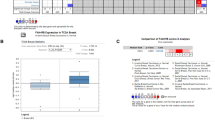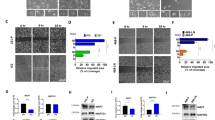Abstract
A novel highly metastatic MDA-MB-231HM cells, derived from MDA-MB-231, was established in our institute. RT-PCR, real-time PCR and Western blot showed that AF1Q gene was differentially expressed between highly metastatic MDA-MB-231HM cells and its parental MDA-MB-231 cells. However, its molecular mechanisms in breast cancer metastasis remain to be characterized. To investigate the effects of AF1Q on the progression of human breast cancer cells, in the present study, recombinant expression plasmid vectors of the human AF1Q gene was transfected into MDA-MB-231 cells. We demonstrated that AF1Q overexpression enhanced the in vitro proliferation and invasive potential of breast cancer cells. Focused microarray analyses showed that 22 genes were differentially expressed between AF1Q transfected cells and its parental counterparts. Integrin α3, accompanied by up-regulation of Ets-1 and MMP-2, significantly enhanced the in vitro invasive potential of human breast cancer cells mediated by AF1Q. Estrogen-responsive ring finger protein gene (EFP), also played a role in the enhancement of in vitro proliferation of human breast cancer cells mediated by AF1Q, accompanied by down-regulation of 14-3-3δ. The association was ERα independent. These results were further demonstrated by RNA interference (RNAi) experiment in vitro. In in vivo study, we also demonstrated that AF1Q transfected breast cancer cells grew much faster and had more pulmonary metastases than vector-transfected or its parental counterparts. On the contrary, AF1Q knockdown cells grew slower and had less pulmonary metastasis. Similar effects of AF1Q on integrin α3, Ets-1, MMP-2, EFP, and 14-3-3δ expression observed in vitro studies were also found in the in vivo study. Taken together, these results provide functional evidences that overexpression of AF1Q leads to a more progression in human breast cancer, at least in part, through regulating the integrin α3, Ets-1, MMP-2, EFP, and 14-3-3δ expression.








Similar content being viewed by others
References
Jemal A, Siegel R, Ward E, Murray T, Xu J, Thun MJ (2007) Cancer statistics, 2007. CA Cancer J Clin 57(1):43–66
Beckmann MW, Niederacher D, Schnurch HG, Gusterson BA, Bender HG (1997) Multistep carcinogenesis of breast cancer and tumour heterogeneity. J Mol Med 75(6):429–439
Li DQ, Wang L, Fei F, Hou YF, Luo JM, Zeng R, Wu J, Lu JS, Di GH, Ou ZL et al (2006) Identification of breast cancer metastasis-associated proteins in an isogenic tumor metastasis model using two-dimensional gel electrophoresis and liquid chromatography-ion trap-mass spectrometry. Proteomics 6(11):3352–3368
Li DQ, Hou YF, Wu J, Chen Y, Lu JS, Di GH, Ou ZL, Shen ZZ, Ding J, Shao ZM (2006) Gene expression profile analysis of an isogenic tumour metastasis model reveals a functional role for oncogene AF1Q in breast cancer metastasis. Eur J Cancer 42(18):3274–3286
Jacques C, Baris O, Prunier-Mirebeau D, Savagner F, Rodien P, Rohmer V, Franc B, Guyetant S, Malthiery Y, Reynier P (2005) Two-step differential expression analysis reveals a new set of genes involved in thyroid oncocytic tumors. J Clin Endocrinol Metab 90(4):2314–2320
So CW, Ma SK, Wan TS, Chan GC, Ha SY, Chan LC (2000) Analysis of MLL-derived transcripts in infant acute monocytic leukemia with a complex translocation (1;11;4)(q21;q23;p16). Cancer Genet Cytogenet 117(1):24–27
Tse W, Meshinchi S, Alonzo TA, Stirewalt DL, Gerbing RB, Woods WG, Appelbaum FR, Radich JP (2004) Elevated expression of the AF1q gene, an MLL fusion partner, is an independent adverse prognostic factor in pediatric acute myeloid leukemia. Blood 104(10):3058–3063
Tse W, Joachim Deeg H, Stirewalt D, Appelbaum FR, Radich J, Gooley T (2005) Increased AF1q gene expression in high-risk myelodysplastic syndrome. Br J Haematol 128(2):218–220
Chang XZ, Wang ZM, Yu JM, Tian FG, Jin W, Zhang Y, Yu J, Li LF, Liu XF, Li ZW et al (2007) Isolation of a human gallbladder cancer cell clone with high invasive phenotype in vitro and metastatic potential in orthotopic model and inhibition of its invasiveness by heparanase antisense oligodeoxynucleotides. Clin Exp Metastasis 24(1):25–38
Zhang Z, Futamura M, Vikis HG, Wang M, Li J, Wang Y, Guan KL, You M (2003) Positional cloning of the major quantitative trait locus underlying lung tumor susceptibility in mice. Proc Natl Acad Sci USA 100(22):12642–12647
Albini A, Iwamoto Y, Kleinman HK, Martin GR, Aaronson SA, Kozlowski JM, McEwan RN (1987) A rapid in vitro assay for quantitating the invasive potential of tumor cells. Cancer Res 47(12):3239–3245
Hou YF, Yuan ST, Li HC, Wu J, Lu JS, Liu G, Lu LJ, Shen ZZ, Ding J, Shao ZM (2004) ERbeta exerts multiple stimulative effects on human breast carcinoma cells. Oncogene 23(34):5799–5806
Tse W, Zhu W, Chen HS, Cohen A (1995) A novel gene, AF1q, fused to MLL in t(1;11) (q21;q23), is specifically expressed in leukemic and immature hematopoietic cells. Blood 85(3):650–656
Lin HJ, Shaffer KM, Sun Z, Jay G, He WW, Ma W (2004) AF1q, a differentially expressed gene during neuronal differentiation, transforms HEK cells into neuron-like cells. Brain Res Mol Brain Res 131(1–2):126–130
Morini M, Mottolese M, Ferrari N, Ghiorzo F, Buglioni S, Mortarini R, Noonan DM, Natali PG, Albini A (2000) The alpha 3 beta 1 integrin is associated with mammary carcinoma cell metastasis, invasion, and gelatinase B (MMP-9) activity. Int J Cancer 87(3):336–342
Nishimura S, Chung YS, Yashiro M, Inoue T, Sowa M (1996) Role of alpha 2 beta 1- and alpha 3 beta 1-integrin in the peritoneal implantation of scirrhous gastric carcinoma. Br J Cancer 74(9):1406–1412
Pochec E, Litynska A, Amoresano A, Casbarra A (2003) Glycosylation profile of integrin alpha 3 beta 1 changes with melanoma progression. Biochim Biophys Acta 1643(1–3):113–123
Baum O, Hlushchuk R, Forster A, Greiner R, Clezardin P, Zhao Y, Djonov V, Gruber G (2007) Increased invasive potential and up-regulation of MMP-2 in MDA-MB-231 breast cancer cells expressing the beta3 integrin subunit. Int J Oncol 30(2):325–332
Chen X, Su Y, Fingleton B, Acuff H, Matrisian LM, Zent R, Pozzi A (2005) Increased plasma MMP9 in integrin alpha1-null mice enhances lung metastasis of colon carcinoma cells. Int J Cancer 116(1):52–61
Fouchier F, Penel C, Pierre Montero M, Bremond P, Champion S (2007) Integrin alphavbeta6 mediates HT29-D4 cell adhesion to MMP-processed fibrinogen in the presence of Mn(2+). Eur J Cell Biol 86(3):143–160
Kato T, Katabami K, Takatsuki H, Han SA, Takeuchi K, Irimura T, Tsuji T (2002) Characterization of the promoter for the mouse alpha 3 integrin gene. Eur J Biochem 269(18):4524–4532
Taki M, Verschueren K, Yokoyama K, Nagayama M, Kamata N (2006) Involvement of Ets-1 transcription factor in inducing matrix metalloproteinase-2 expression by epithelial-mesenchymal transition in human squamous carcinoma cells. Int J Oncol 28(2):487–496
Yamamoto H, Horiuchi S, Adachi Y, Taniguchi H, Nosho K, Min Y, Imai K (2004) Expression of ets-related transcriptional factor E1AF is associated with tumor progression and over-expression of matrilysin in human gastric cancer. Carcinogenesis 25(3):325–332
Inoue S, Orimo A, Hosoi T, Kondo S, Toyoshima H, Kondo T, Ikegami A, Ouchi Y, Orimo H, Muramatsu M (1993) Genomic binding-site cloning reveals an estrogen-responsive gene that encodes a RING finger protein. Proc Natl Acad Sci USA 90(23):11117–11121
Horie-Inoue K, Inoue S (2006) Epigenetic and proteolytic inactivation of 14–3-3sigma in breast and prostate cancers. Semin Cancer Biol 16(3):235–239
Ikeda K, Inoue S (2004) Estrogen receptors and their downstream targets in cancer. Arch Histol Cytol 67(5):435–442
Suzuki T, Urano T, Tsukui T, Horie-Inoue K, Moriya T, Ishida T, Muramatsu M, Ouchi Y, Sasano H, Inoue S (2005) Estrogen-responsive finger protein as a new potential biomarker for breast cancer. Clin Cancer Res 11(17):6148–6154
Urano T, Saito T, Tsukui T, Fujita M, Hosoi T, Muramatsu M, Ouchi Y, Inoue S (2002) Efp targets 14–3-3 sigma for proteolysis and promotes breast tumour growth. Nature 417(6891):871–875
Acknowledgements
This research was supported in part by the grants from 973 (2006CB0D0901), National Natural Science Foundation of China (30371580, 30572109 to ZM. S.); Shanghai Science and Technology Committee (03J14019, 06DJ14004, 06DZ19504; to ZM. S.); China Postdoctoral Science Foundation (20060390141 to XZ. C.).
Author information
Authors and Affiliations
Corresponding author
Rights and permissions
About this article
Cite this article
Chang, XZ., Li, DQ., Hou, YF. et al. Identification of the functional role of AF1Q in the progression of breast cancer. Breast Cancer Res Treat 111, 65–78 (2008). https://doi.org/10.1007/s10549-007-9761-y
Received:
Accepted:
Published:
Issue Date:
DOI: https://doi.org/10.1007/s10549-007-9761-y




